Key takeaways:
- User-friendly interfaces enhance user experience by prioritizing ease of navigation and intuitive design.
- Simplicity and customization in design foster confidence and accessibility for users of all skill levels.
- Samsung’s One UI emphasizes personalization and seamless integration across devices, improving overall usability.
- Key features like Smart View and multi-window capabilities enhance social interactions and multitasking efficiency.
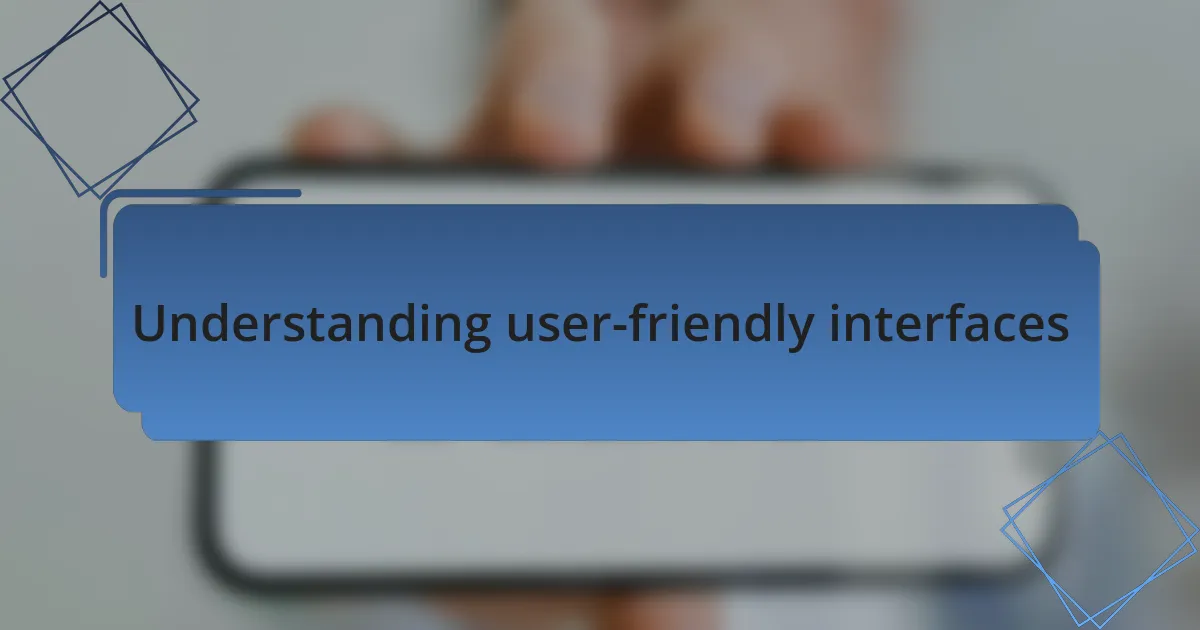
Understanding user-friendly interfaces
When I think about user-friendly interfaces, I consider how they transform the way we interact with technology. For instance, I remember my first experience with a smartphone that had a particularly intuitive design. Navigating through its features felt seamless, almost like an extension of my own thoughts, which made me wonder: how much more efficient would our digital lives be if every interface prioritized ease of use?
A user-friendly interface isn’t just about aesthetics; it’s about functionality that meets the user’s needs. I recall a time when I struggled with an application that was visually pleasing but clunky to navigate. This experience taught me the importance of an interface that feels natural—something that anticipates my questions and guides me effortlessly. Have you ever felt frustrated when trying to access essential features? It’s a common sentiment, and it underscores why understanding user experience is crucial.
Moreover, a truly user-friendly interface often speaks to the user’s emotions. I’ve felt a sense of accomplishment when successfully using a feature without external help, highlighting the confidence that comes from intuitive design. It’s all about creating a relationship between the user and the interface—one where the technology enhances the experience rather than complicates it. How can developers ensure this connection is maintained? By placing the user at the center of their design process.
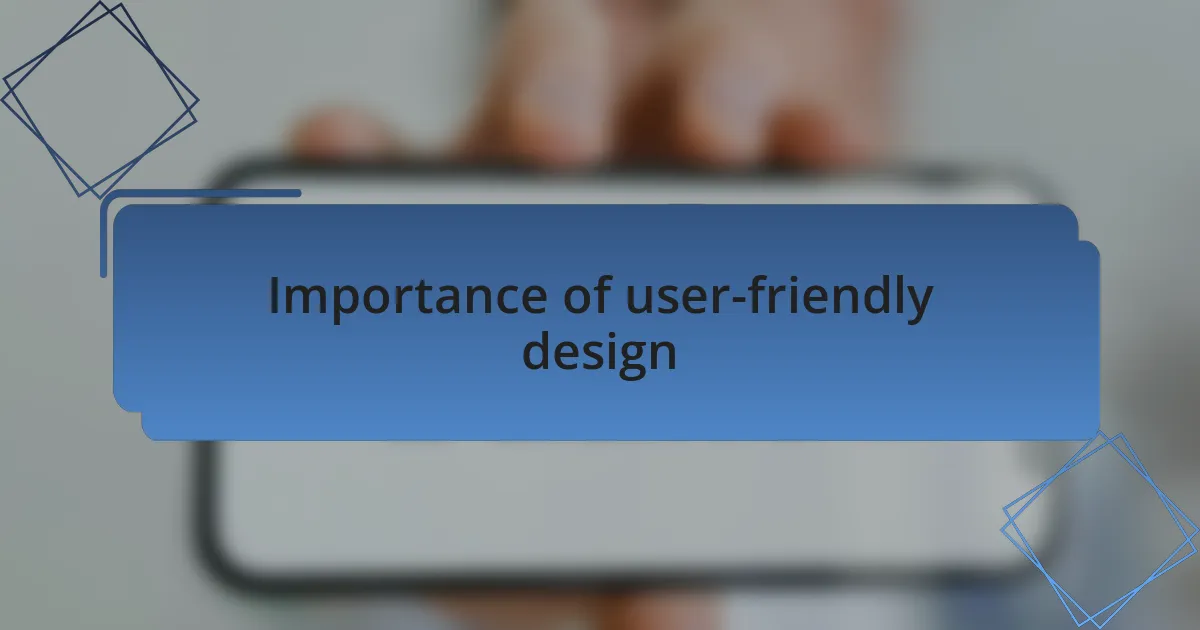
Importance of user-friendly design
User-friendly design is essential because it directly impacts how people perceive and interact with technology. I still remember wrestling with my first tablet; it looked great, but finding simple functions was a challenge. This struggle made me realize that if design overlooks usability, even the best features can become frustrating barriers, leaving users feeling overwhelmed and disconnected.
Simplicity in design fosters confidence. For me, there was a moment of pure relief when I discovered a smartphone that allowed me to customize my home screen effortlessly. It felt empowering to create an interface tailored to my needs, reinforcing how user-friendly design can enhance my daily interactions with technology. Have you experienced that wonderful feeling of being in control of your device? It’s a game-changer.
Additionally, a user-friendly interface can significantly reduce the learning curve for new users. I once introduced a friend to a sleek new smartphone. They picked it up and immediately began exploring without any instructions, which surprised me. That moment highlighted how a good design can make technology accessible to everyone, bridging the gap between tech-savvy and novice users. Isn’t that the ultimate goal? Creating inclusive experiences that invite all users to engage without hesitation?
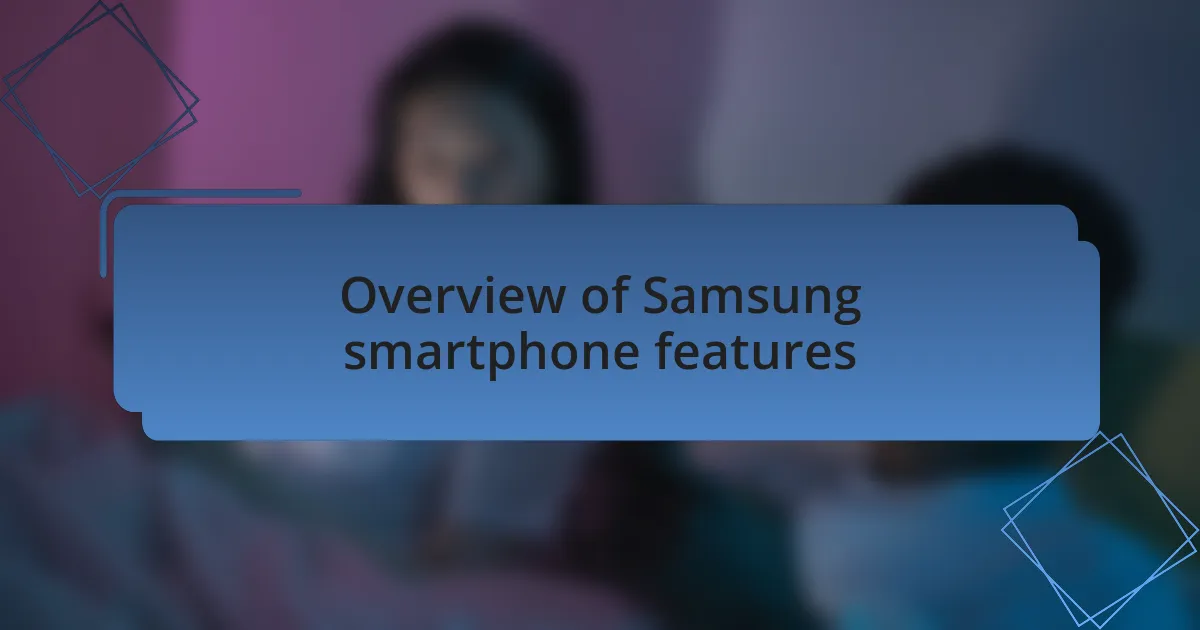
Overview of Samsung smartphone features
Samsung smartphones are packed with impressive features that cater to a diverse user base. For instance, I was genuinely amazed by the camera capabilities when I first used a Galaxy model. The clarity and detail in low-light settings made me feel like a professional photographer – who wouldn’t want to capture spontaneous moments as they unfold, right?
Beyond photography, Samsung’s interface offers a level of customization that had me experimenting for hours. I remember the thrill of rearranging my apps and widgets to create a layout that truly felt like mine. It’s not just about aesthetics; it’s about crafting a personal digital space where functionality and creativity coexist. Have you ever felt that rush of excitement when your smartphone reflects your personality?
The integration of Samsung’s ecosystem also stands out. The seamless connection between my smartphone and other devices, like my smartwatch and tablet, made everyday tasks much easier. I’ve found that instantly accessing notifications or responding to messages across devices has not only improved my productivity but also my overall enjoyment of technology. Isn’t it wonderful how a well-designed interface can simplify our lives and enhance our tech experience?
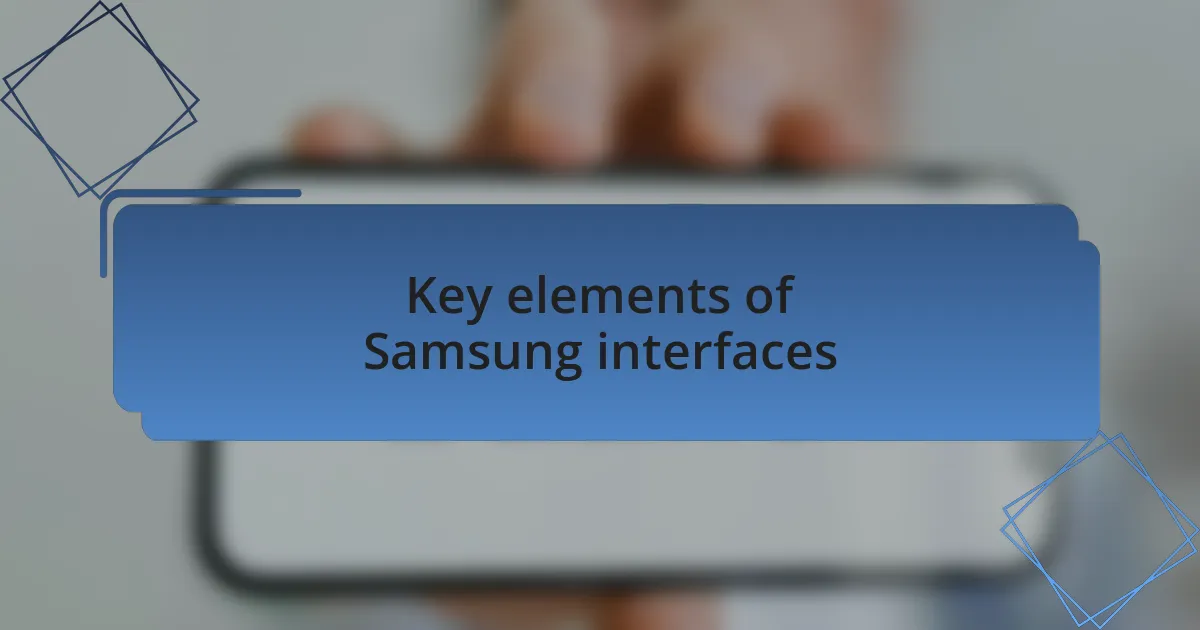
Key elements of Samsung interfaces
When I think about the key elements of Samsung interfaces, the first thing that comes to mind is the user-centric design. It’s impressive how intuitive it feels right from the first touch. I remember the moment I picked up my first Galaxy device; navigating through settings was so seamless that I felt like I could conquer the phone immediately. Wouldn’t you agree that a user-friendly setup can dramatically reduce frustration when you’re trying to learn a new device?
Another vital aspect is Samsung’s One UI, which strikes a perfect balance between functionality and style. The layout is clean yet vibrant, allowing for easy access to essential features. I vividly recall how the dark mode feature transformed late-night browsing sessions, making everything more visually comfortable while adding a sophisticated touch. Have you ever wondered how much easier a simple color scheme can make your daily tasks?
Moreover, the emphasis on accessibility really sets Samsung apart. Features like screen readers and customizable fonts make it inclusive for all users. On a personal level, I found these options particularly helpful when my friend—who has a visual impairment—was able to navigate the interface with confidence. It’s inspiring to see a company prioritize inclusivity, showing that great design considers everyone. Isn’t it amazing how thoughtful features can open up technology to a broader audience?
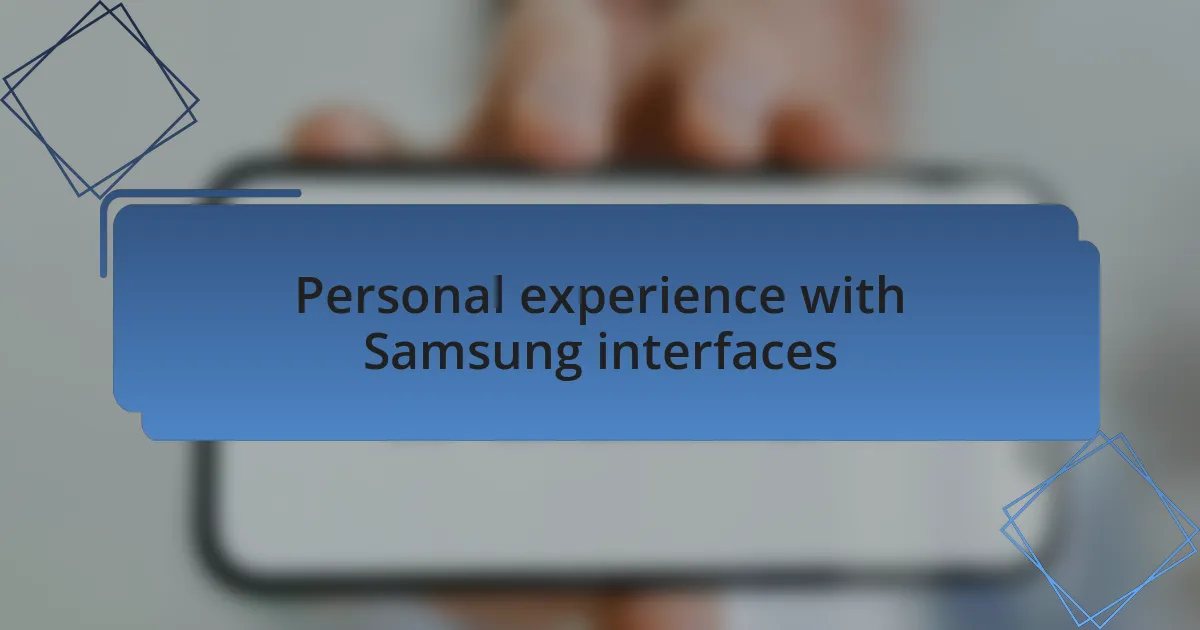
Personal experience with Samsung interfaces
When I first interacted with Samsung’s interface on my Galaxy S series, I was struck by how seamlessly it combined practicality with aesthetics. I still remember the thrill of customizing my home screen with widgets that suited my lifestyle; it felt like my device truly reflected my personality. Isn’t it remarkable how personalization can make a device feel more like an extension of ourselves?
One moment that stands out is when I discovered the Smart View feature. I was at a friend’s gathering, trying to share photos directly from my phone to their TV. The ease of connecting and sharing on a larger screen made it feel as if the technology was working in tune with our social interactions. How often do we encounter technology that enhances our shared experiences in such a simple way?
Additionally, I’ve had my fair share of “aha” moments while navigating Samsung’s settings. It’s those little surprises, like finding the Adaptive Battery feature, that have left a lasting impression. I remember being amazed at how it learned my habits, optimizing battery life without any manual adjustments required. Doesn’t it feel great when technology anticipates our needs and just works?

Comparing Samsung to other brands
When I compare Samsung to other brands like Apple and Google, I notice a distinct approach to user interfaces. Samsung’s One UI, with its focus on customization, feels more versatile than the somewhat rigid interfaces I’ve experienced on other platforms. For example, while Apple prioritizes a streamlined experience, I often find myself missing the little personal touches I can add on my Samsung device.
I’ve also found navigating Samsung’s settings more intuitive compared to some of the other brands I’ve tried. I recall a time when I switched from a competitor’s smartphone; it took me ages to locate features I needed. In contrast, Samsung’s organized layout made it easier to explore options like Bixby Routines, which I found incredibly useful for automating daily tasks.
While messaging apps and social media experiences can vary, I appreciate how Samsung integrates these functionalities within its ecosystem. I was thrilled when I realized that sharing files directly with other Samsung devices was faster and effortless, making me feel more connected. Unlike some other brands that complicate the sharing process, Samsung makes it second nature. Doesn’t it feel comforting when technology aligns with our daily habits?
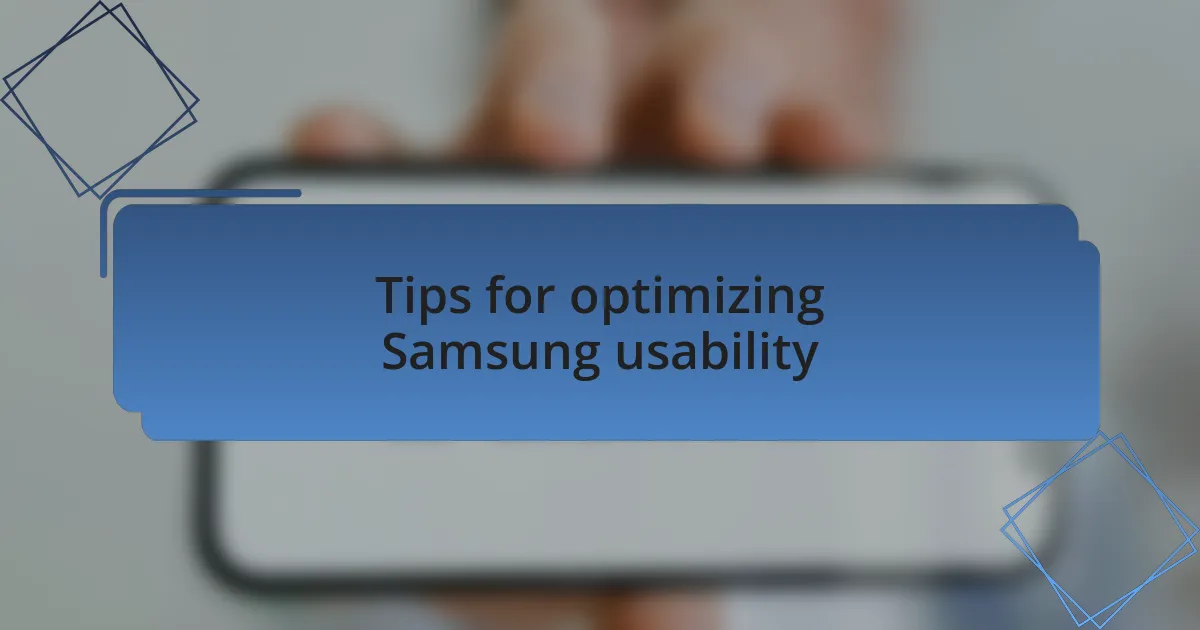
Tips for optimizing Samsung usability
When optimizing usability on Samsung devices, I’ve found that customizing the home screen can significantly enhance my experience. By arranging widgets and apps based on my daily routines, I’m able to access what I need without wasting time. Have you tried adding your most-used apps at your fingertips? It’s like having a personal concierge right on your device.
Another tip is to dive into the accessibility settings. For instance, when I adjusted the screen zoom and font size, it made a world of difference, especially when reading articles or texts. It’s fascinating how small tweaks can lead to a more comfortable and engaging interaction, isn’t it?
Lastly, take advantage of Samsung’s multi-window feature. I remember juggling between tasks one day, and the ability to split my screen was a game changer. I could chat with a friend while watching videos, all without missing a beat. How often do we multitask in our daily lives? This feature not only boosts productivity but also transforms how I use my smartphone throughout the day.